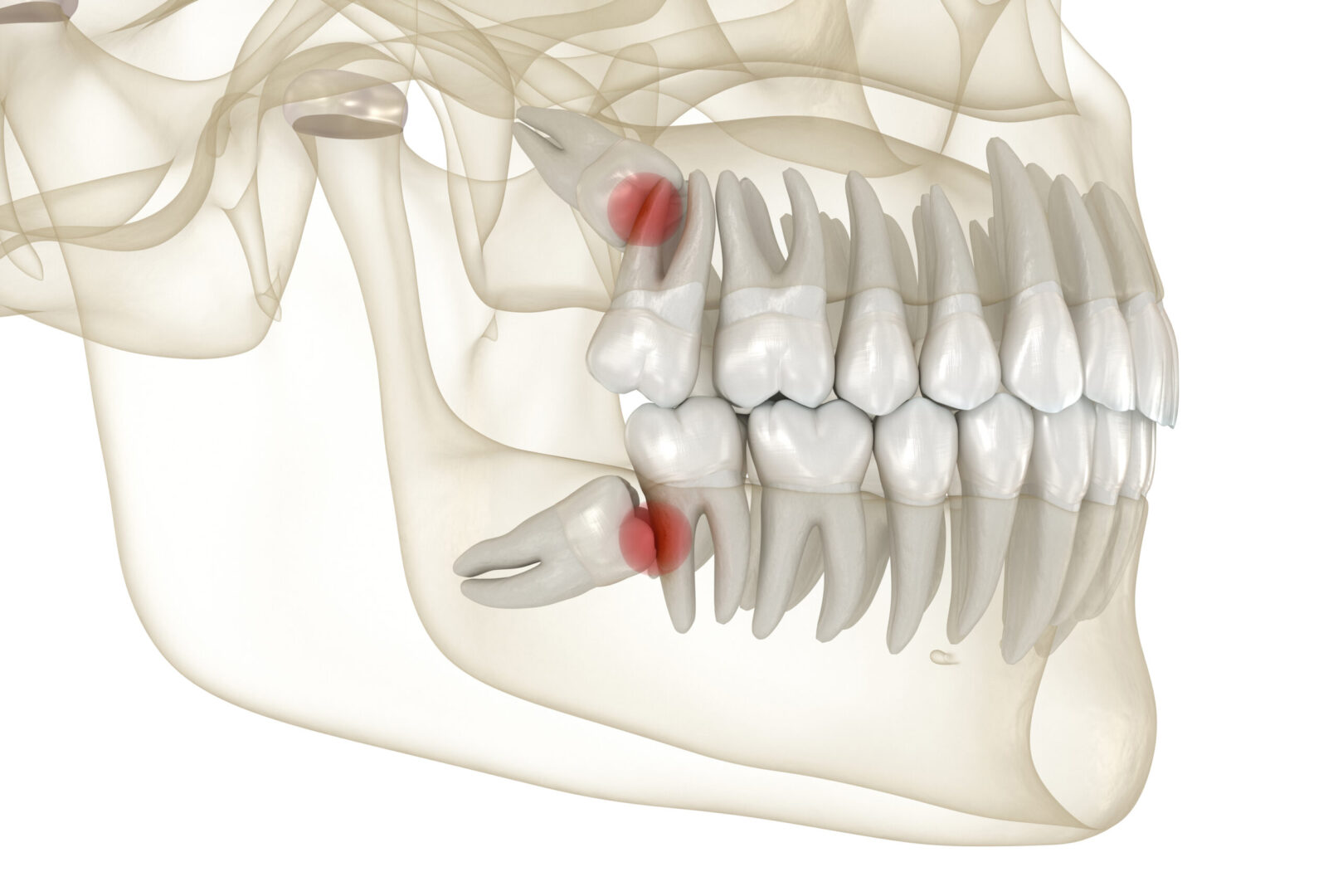Why do we extract wisdom teeth?
Wisdom teeth need to be extracted for several reasons:
- Impacted wisdom teeth: meaning that they don’t fully emerge out of the jaw bones.
Impacted wisdom teeth can cause pain and swelling in the gum around the tooth ( pericoronitis). They can also push against neighboring teeth, causing misalignment and cavities at the neck of the tooth in front of them (2nd molar). Periodontal pockets can appear between wisdom teeth and 2nd molars, causing bone resorption and ultimately the extraction of both 2nd and 3rd molars.
- Infection and Gum Disease: Wisdom teeth are at the very back of the mouth, making them very difficult to clean properly, leading to infection, gum disease, and dental cavities.
- Tooth misalignment: Wisdom teeth can exert pressure on existing teeth, leading to crowding and shifting of the teeth in your mouth. Wisdom tooth removals are always recommended after orthodontic treatments.
- Cysts and Tumors: impacted wisdom teeth inside their tooth sacs which are buried completely inside the bone can cause cysts or even tumors, potentially leading to more serious health problems.
Steps of wisdom tooth removal?
Examination: Before the extraction, X-rays picture will be taken to determine the position of your wisdom teeth and the best approach for removal.
Injection:
Extraction: The dentist will then proceed with the extraction. An incision in the gum tissue to get to the tooth may be made if it’s impacted or hasn’t fully erupted. The tooth may be cut into smaller pieces to be taken out easier.
Stitches: to close the incision after the tooth is removed
Instructions on post-operative care, including pain management, diet, and oral hygiene.
Follow-up: to ensure proper healing and remove stitches.
Wisdom tooth extraction is a safe and routine procedure. Discomfort or pain are common during recovery and vary from person to person.
What is CBCT? Why is it recommended for wisdom tooth extraction?
CBCT (Cone Beam Computed Tomography) record radiography images in 3 dimensions. It can assist wisdom tooth extraction in several ways:
A 3D image of the teeth and their surroundings: highly detailed 3D images of the jaws, teeth, and surrounding structures can be obtained with CBCT, providing a comprehensive view of the area, including the exact position of the wisdom tooth in relation to adjacent nerves, bones, and other structures.
Precise Treatment Planning: CBCT scans help planning wisdom tooth extractions more accurately. They show the tooth’s orientation, its proximity to vital structures, and whether it’s impacted (partially or fully submerged in the jawbone)
Reduced Complications: A clear view of the surgical site can help minimize the risk of complications during the extraction, such as nerve damage or damage to adjacent teeth, leading to safer and more predictable outcomes.
Enhanced Patient Comfort: Better pre-operative assessment and surgery plans result in smoother and less traumatic extractions, less post-operative pain and faster recovery times for patients.
Overall, CBCT imaging is an essential tool in dentistry, especially in complex procedures like wisdom tooth extractions.
CBCT images show that my wisdom tooth is closed to the nerve. What does it mean?
It means that the tooth’s roots are close to the inferior alveolar nerve, which supply the lower jaw. This nerve provides sensation to the lower lip, chin, and tongue.
Some potential risks and complications during extraction if your teeth are close to the nerve:
Nerve Damage: can result in temporary or, in rare cases, permanent numbness or altered sensation in the lower lip, chin, or tongue on the affected side.
Surgical Difficulty : Wisdom teeth close to the nerve require a more complex surgical approach to avoid complications
Is it compulsory to take antibiotics after wisdom tooth extraction?
Antibiotic after wisdom tooth extraction is not recommended in all cases., however If antibiotics are prescribed, take them as directed, even if you start feeling better after 2-3 days to prevent the development of antibiotic-resistant bacteria.
How many days will it hurt after wisdom tooth extraction? What should I do when it hurts?
Pain and discomfort after wisdom tooth extraction can vary from person to person
Immediate after wisdom tooth extraction (1-3 Days): It’s common to have the most pain and swelling in the first 1 to 3 days after the extraction. During this time, you should avoid heavy physical activities, and follow your dentist’s instructions for pain management.
Following Days (4-7 Days): Pain and swelling begin to subside. However, some discomfort may persist for a week or more, especially if the extraction was a difficult one.
To manage pain and promote healing, you should:
Take Pain Killers. ( Algoflex, Cataflam)
Applying ice packs helps reduce swelling and relieve discomfort. Use them for 20 minutes on your cheek near the surgical area.
Rest: Make the healing process quicker.
Soft Diet: Foods like yogurt, mashed potatoes, and soup for few days. Avoid hot, spicy, and hard foods.
Oral Hygiene: Follow your dentist’s instructions
No Smoking and Alcohol
Follow-Up Appointments
Pain should gradually decrease as you heal. If you experience severe or worsening pain, persistent bleeding, signs of infection (fever, pus), or any other concerning symptoms, contact your dentist immediately.

